We are living in an era of communication
wherein we can easily transfer any information (video, audio and other
data) in the form of electrical signals to any other device or destined
area. Although it is common in our perceptual experience that sending or
receiving signals or data is simple, but it involves quite complex
procedures, possibilities and scenarios within the communication systems.
Modulation plays a key role in
communication system to encode information digitally in analog world. It
is very important to modulate the signals before sending them to the
receiver section for larger distance transfer, accurate data transfer
and low-noise data reception.
What is Modulation?
Modulation is a process of changing the
characteristics of the wave to be transmitted by superimposing the
message signal on the high frequency signal. In this process video,
voice and other data signals modify high frequency signals – also known
as carrier wave. This carrier wave can be DC or AC or pulse chain
depending on the application used. Usually high frequency sine wave is
used as a carrier wave signal.
These modulation techniques are classified into two major types: analog and digital or pulse modulation.
Prior to discussing further about the different types of modulation
techniques, let us understand the importance of modulation.
Why modulation is used in communication?
- In modulation technique, the message signal frequency is raised to a range so that it is more useful for transmission. The following points describe modulation’s importance in communication system.
- In signal transmission, the signals from various sources are transmitted through a common channel simultaneously by using multiplexers. If these signals are transmitted simultaneously with certain bandwidth, they cause interference. To overcome this, speech signals are modulated to various carrier frequencies in order for the receiver to tune them to desired bandwidth of his own choice within the range of transmission.
- Another technical reason is antenna size; the antenna size is inversely proportional to the frequency of the radiated signal. The order of the antenna aperture size is at least one by tenth of the wavelength of the signal. Its size is not practicable if the signal is 5 KHz; therefore, raising frequency by modulating process will certainly reduce the height of the antenna.
- Modulation is important to transfer the signals over large distances, since it is not possible to send low-frequency signals for longer distances.
- Similarly, modulation is also important to allocate more channels for users and to increase noise immunity.
Different Types of Modulation
The
two types of modulation: analog and digital modulation techniques have
already been discussed. In both the techniques, the baseband information
is converted to Radio Frequency signals, but in analog modulation these
RF communication signals are continuous range of values, whereas in digital modulation these are prearranged discrete states.
Analog Modulation
In this modulation, a continuously
varying sine wave is used as a carrier wave that modulates the message
signal or data signal. The Sinusoidal wave’s general function is shown
in the figure below, in which, three parameters can be altered to get
modulation – they are amplitude, frequency and phase, so the types of
analog modulation are:
- Amplitude modulation (AM)
- Frequency modulation (FM)
- Phase modulation (PM)
In amplitude modulation,
the amplitude of the carrier wave is varied in proportion to the
message signal, and the other factors like frequency and phase remain
constant. The modulated signal is shown in the below figure, and its
spectrum consists of lower frequency band, upper frequency band and
carrier frequency components. This type of modulation requires greater
band width, more power. Filtering is very difficult in this modulation.
Frequency modulation
(FM) varies the frequency of the carrier in proportion to the message or
data signal while maintaining other parameters constant. The advantage
of FM over AM is the greater suppression of noise at the expense of
bandwidth in FM. It is used in applications like radio, radar, telemetry
seismic prospecting, and so on. The efficiency and bandwidths depend on
modulation index and maximum modulating frequency.
In phase modulation,
the carrier phase is varied in accordance with the data signal. In this
type of modulation, when the phase is changed it also affects the
frequency, so this modulation also comes under frequency modulation.
Analog modulation (AM, FM and PM) is
more sensitive to noise. If noise enters into a system, it persists and
gets carried till the end receiver. Therefore, this drawback can be
overcome by the digital modulation technique.
Digital Modulation
For a better quality and efficient
communication, digital modulation technique is employed. The main
advantages of the digital modulation over analog modulation include
permissible power, available bandwidth and high noise immunity. In
digital modulation, a message signal is converted from analog to digital
message, and then modulated by using a carrier wave.
The carrier wave is keyed or switched on
and off to create pulses such that the signal is modulated. Similar to
the analog, here the parameters like amplitude, frequency and phase
variation of the carrier wave decides the type of digital modulation.
Digital modulation is of several types
depending on the type of signal and application used such as Amplitude
Shift Keying, Frequency Shift Keying, Phase Shift Keying, Differential
Phase Shift Keying, Quadrature Phase Shift Keying, Minimum Shift Keying,
Gaussian Minimum Shift Keying, Orthogonal Frequency Division
Multiplexing, etc., as shown in the figure.
Amplitude shift keying changes the
amplitude of the carrier wave based on the base band signal or message
signal, which is in digital format. It is used for low-band requirements
and is sensitive to noise.
In frequency shift keying, the frequency
of the carrier wave is varied for each symbol in the digital data. It
needs larger bandwidths as shown in the figure. Similarly, the phase
shift keying changes the phase of the carrier for each symbol and it is
less sensitive to noise.
To avoid making this article complex,
some mathematical equations and in-depth information about digital
communication systems have been exempted from it. However, the efforts
put in to bring forth this article ensure basic information on different
types of modulation in communication system. And therefore, the readers
can share their ideas, suggestions and comments in the comment section
below.



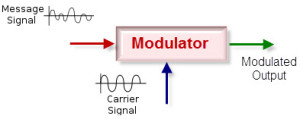
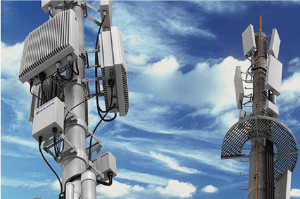
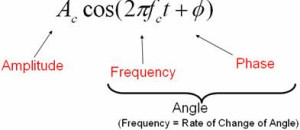
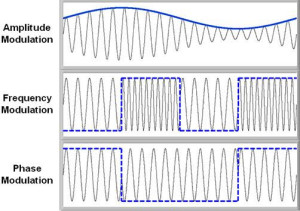
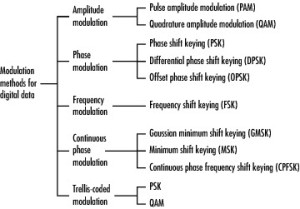
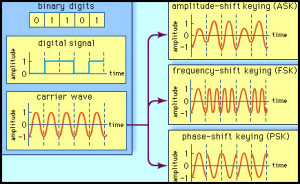




No comments:
Post a Comment